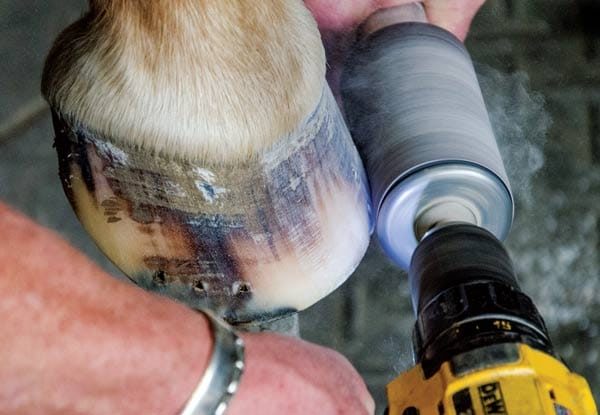It’s always best to prevent a white line disease infection rather than fight one. Simply put, the alternative often results in a fight that’s difficult to contain. While hoof-care clients can spearhead prevention by providing a clean and dry living environment for their horses, farriers are likely the first line of defense.
The University of California, Davis Center for Equine Health cites in its Fall 2019 Horse Report what many farriers, including Sagamore Beach, Mass., farrier Nick Denson, believe, “Hot fitting kills microbes and can help dry the hoof, making for stronger-holding nails.”
While well-respected farriers around the United States have debated the merits of using a buffy on horn, Denson believes it has an advantage over rasping.
“Buffing the hoof wall can help eliminate microscopic nooks and crannies that can harbor fungus,” he says.
Denson and other farriers like David Hallock, who leads the Michigan State University Farrier School, suggest addressing hoof wall defects immediately.
“If you see any hoof wall separations, clean them out and pack it with something, whether it’s a commercially available product, copper sulfate or beeswax,” Hallock says. “You want to be proactive because it will make a difference. It’s similar to thrush in that if you keep the foot clean and brush an antibacterial/antifungal on it, then you’re better off than if you need to fix a completely rotted and nasty looking frog. Staying ahead of it is the best option.”
What do you do to prevent white line disease? Share your methods below in the comment section.
Learn More
- Study Pinpoints Fungi as Cause, Confirms White Line Disease Treatment: Hall of Fame farrier Michael Wildenstein conducted a study that eliminated any doubts that hoof wall separations attributable to white line disease are caused by fungi that can be treated with a chlorine dioxide solution.
- UC Davis Treats White Line Disease with Surgical Laser: Innovative approach eliminates previously undetectable pockets of bacteria and fungus.
- White Line Disease: Different Approaches to an Old Problem: Our in-depth eGuide on white line disease aims to dramatically help the horses in your practice suffering from this ailment, and it’s FREE!








